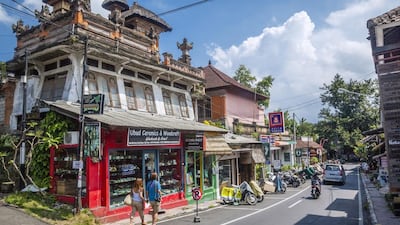Why Ubud?
Ubud rests at Bali’s very heart – geographically and metaphorically – in the cooler central highlands. The island’s arts, cultural and spiritual epicentre for centuries, this royal town is where you’ll find a more “authentic” Bali. Here, locals fiercely cling to deeply rooted Hindu traditions, omnipresent in ornate ceremonies and weathered temples. Ubud, however, is fast evolving as Bali’s hottest foodie destination and a sought-after yoga, spa and wellness Asian epicentre – a holistic bolt-hole emanating regenerative energy.
Find your feet
Ubud is a series of ancient villages blurred together; most key attractions are accessible by foot within the densely packed centre. The main street, Jalan Raya Ubud, running east to west, is skewered by Monkey Forest Road, running southwards to tourist-magnet Monkey Forest. These, plus off-shoot streets, are jam-packed with guest houses, cafés, restaurants, handicraft stores and galleries. Ubud’s outer fringes reveal traditional villages, jade-green rice terraces – the most Instagram-worthy, like Tegallalang, 10 kilometres north – and rainforested river valleys, including Sayan, where world-class resorts are elevated for spectacular ravine views. Eastwards, the countryside is littered with revered archaeological sites and Hindu temples – easily reached by car.
A comfortable bed
Whatever the budget, most accommodation drips with Balinese aesthetics and traditions, vying for the best up-close rice paddy views. Among Komaneka's (www.komaneka.com) high-end boutique resorts spread across Ubud – all focusing on Indonesian art and heritage, but good value (from 4.84m Indonesian Rupiah [Dh1,362] including breakfast and taxes) and family-owned – Komaneka at Bisma is the star, offering contemporary understated luxury high in the hills (accommodation includes a swanky tree-house residence) yet just a short stroll from Ubud's centre. In sleepy farmlands, former private estate The Chedi Club Tanah Gajah (www.ghmhotels.com/en/tanah-gajah) incorporates working rice paddies and organic gardens in pretty landscaped grounds surrounding the 20 suites and villas, spa and open-air restaurant (a suite costs from 554,180 Indonesian Rupiah [Dh1,559] per night including breakfast, butler service, afternoon tea, sunset cocktails and taxes).
Meet the locals
Translating as medicine in Balinese language, Ubud naturally evolved as a healing and spirituality hotspot, with an extraordinary quota of local holistic healers and practitioners of alternative health. Arrange a private meeting with an authentic Balian for some spiritual spring-cleaning and chakra alignment.
Book a table
Ubud dishes up a mouth- watering dining scene and funky café culture – but at affordable prices – with Bali's leading tally of eateries committed to living raw cuisine and farm-to-table philosophy, showcasing organic, local produce. Mega-popular since 2013 (reservations are essential), modern European cuisine at Locavore (www.restaurantlocavore.com) incorporates practically all Indonesian-sourced produce in multi-course tasting menus, from 665,500 Indonesian Rupiah (Dh187). Meticulously assembled dishes present mini-works of genius, like raw lamb served with pickled fennel and seaweed crème. Duck is Ubud's speciality dish, especially, Bebek Betutu, a ceremonial smoked-duck dish, wrapped in spices and banana leaves then slow-roasted. Sample this house delicacy for IDR127,500 (Dh36), or other duck dishes, at Bebek Tepi Sawah (www.bebektepisawahrestaurant.com), a heavenly garden restaurant with thatched dining gazebos overlooking rice paddies.
Shopper’s paradise
Retail therapy comes inspired by the area's arts and crafts heritage. Ubud art market on Jalan Raya Ubud offers an all-in-one souvenir haul, anything from soft-wood carvings to batik fabrics (brush-up on your haggling skills). For better choices and prices, buy at source from outlying artisan villages which specialise in specific crafts; head to Sukawati Village for its superior art market. For upscale buys, Threads of Life (www.threadsoflife.com) supports rural Indonesian communities to preserve declining weaving traditions.
What to avoid
Crowds. A victim of its own popularity, Ubud’s centre can get overrun with visitors and traffic, especially in high season (July and August) and during three annual festivals for yoga, writing and food (which could themselves come under “Don’t miss”).
Don’t miss
Early morning hikes through Ubud's rice paddies and farmlands – best with a local guide; a traditional healer-herbalist couple run Bali Herbal Walks (www.baliherbalwalk.com) identifying medicinal properties of native plants and ancient rice-growing culture. Ubud is best for traditional Balinese music and dance under starry skies, often performed at key cultural venues, like the Royal Palace. Ubud's fine arts pre-eminence is evident by the glut of quality art museums; several, like renowned Neka Art Museum (www.museumneka.com) come housed in garden pavilions devoid of crowds.
Getting there
A return direct flight on Emirates (www.emirates.ae) from Dubai to Bali's international airport takes around nine hours and costs from Dh2,850, including taxes.

